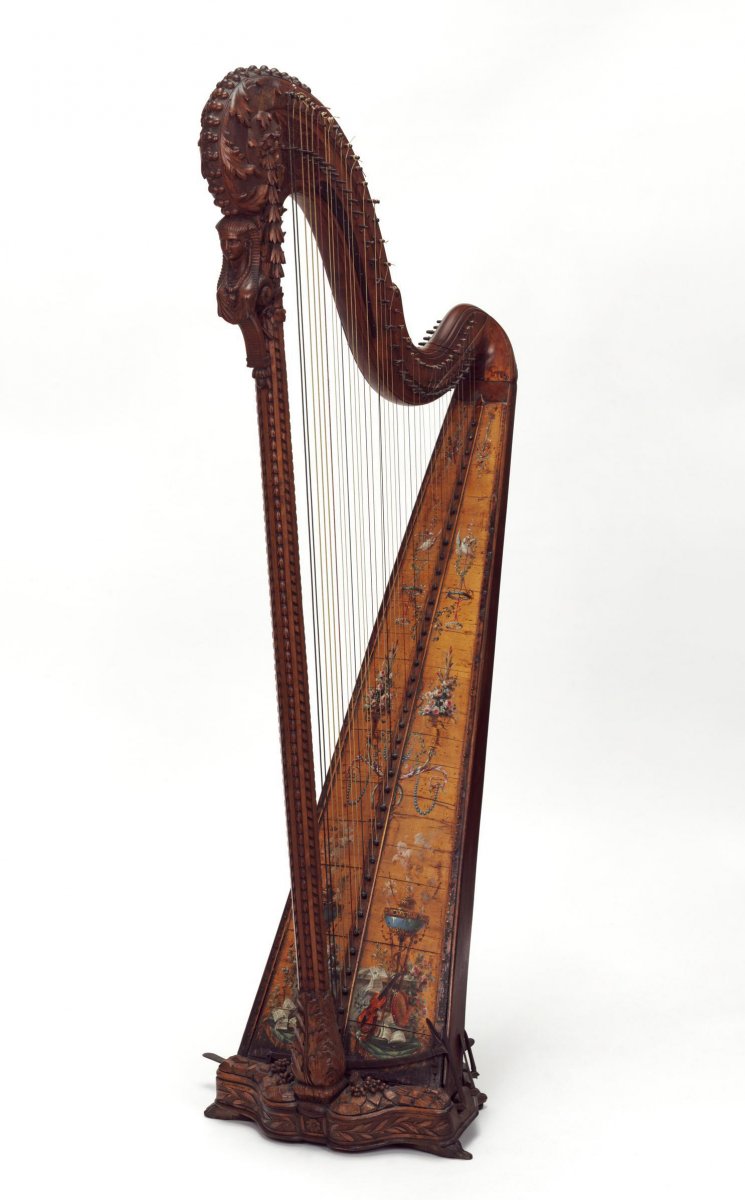Visual Analysis of the harp
The harp was placed in a mirrored room, as part of the collection of Europe from 1600-1815 in the Victorian and Albert Museum. Several components were assembled to construct this wooden musical instrument, with further techniques applied, such as planning and varnishing, for sophisticated decoration.
Placed above the harp’s foot is a resonator box which the strings ran down to. They were secured with the rib, a vertical wooden stripe going in the middle of the soundboard on top of the box. At the back, there were five holes with shutters, controlled by a link connected to one of the eight pedals reaching out of the foot. This fitted mechanism was a significant invention in 1785 by harpist Jean-Baptiste Krumpholz to improve the harp’s construction. It aimed to generate a swell-box effect when the main body resonated and projected the sound. The pedals, at the same time, allowed the player to vary the volume by pressing them to adjust the string pitch. Also standing on the instrument base was the pillar, the longest portion of the harp. It was made in plain birchwood, as well as the neck, which was connected with the sound box at the other end. They conjoined and thus formed a triangle structure that would firmly hold up against the enormous strain of the strings.
The harp was made in 1787 by Jean-Henri Naderman, one of the leading harp-makers in Paris at that time. His outstanding craftsmanship had earned himself a reputation and brought some high-class customers, including the royal family who soon appointed him as the harp supplier. To exemplify with, this fine instrument was specially made for Marie Antoinette, possibly as a wedding present. The exquisiteness might have manifested its status as a royal supply. The pine-made soundboard was delicately painted with doves and bouquets from the top and a tripod scent container surrounded by sprays of flowers, instruments and music scores at the bottom. Carving technique was utilized as well. The base was carved with leaves, as well as the pillar and head, whose junction was a scroll carved with an extra Egyptian Female figure. Nevertheless, there might be a professional painter and carver workshops in charge of the decoration in that similar works were found on other Parisian harps of the period.
Figure 1
Figure 2
The female figure in a headdress was regarded as progressive at its time for that the use of Egyptian motif in interior decoration was not widely appreciated in Europe until Napoleon’s invasion of Egypt gave the impetus for it. However, as a matter of fact, from 1769 to 1815, Neoclassicism was prevailing in European art and design along with a series of archaeological in Greece, Rome, and Egypt. Meanwhile, fashionable furniture was in vogue due to the rising enthusiasm for a leisurely private life. This sophisticated, decorative instrument might serve an accurate reflection of such trends.
Moreover, the harp was given to Queen Marie Antoinette in 1787, merely two years before the royal family moved to Paris under the coercive demand from the indignant crowd. After roughly 200 years, it was placed back in a mirrored room that seemingly refers to the Hall of Mirror in Versailles. Such an ironic coincidence has recalled the last glorious days and the rapid collapse of a vast empire, hence filling me with mixed emotions.
Picture:
- Author unknown. (n.d.). title unknown. [image] Available at: http://collections.vam.ac.uk/item/O109135/harp-naderman-jean-henri/ (Downloaded: 5 November 2018).
- Author unknown. (n.d.). title unknown. [image] Available at: http://collections.vam.ac.uk/item/O109135/harp-naderman-jean-henri/ (Downloaded: 5 November 2018).
Information
Task Requirement:
A visual analysis of a selected object (made between 1770 and 1920) from one of the following London museums [V&A, Tate Britain, National Gallery, Museum of London, Wallace Collection]. This is the summary of your presentation (300-500 words with images)
Selected Object:
 Harp
Harp
1787
France (Paris)
By Jean-Henri Naderman
Painted pine, oak,
Sycamore and birchwood
Museum no. 425-1884
Victoria and Albert Museum
